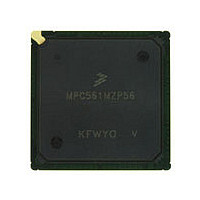MPC561MZP56 Freescale, MPC561MZP56 Datasheet - Page 245

MPC561MZP56
Manufacturer Part Number
MPC561MZP56
Description
Manufacturer
Freescale
Datasheet
1.MPC561MZP56.pdf
(1420 pages)
Specifications of MPC561MZP56
Cpu Family
MPC56x
Device Core
PowerPC
Device Core Size
32b
Frequency (max)
56MHz
Interface Type
QSPI/SCI/SPI/UART
Total Internal Ram Size
32KB
# I/os (max)
56
Number Of Timers - General Purpose
22
Operating Supply Voltage (typ)
2.6/5V
Operating Supply Voltage (max)
2.7/5.25V
Operating Supply Voltage (min)
2.5/4.75V
On-chip Adc
2(32-chx10-bit)
Instruction Set Architecture
RISC
Operating Temp Range
-40C to 125C
Operating Temperature Classification
Automotive
Mounting
Surface Mount
Pin Count
388
Package Type
BGA
Program Memory Type
ROMLess
Program Memory Size
Not Required
Lead Free Status / RoHS Status
Not Compliant
Available stocks
Company
Part Number
Manufacturer
Quantity
Price
Company:
Part Number:
MPC561MZP56
Manufacturer:
Freescale Semiconductor
Quantity:
10 000
Company:
Part Number:
MPC561MZP56R2
Manufacturer:
Freescale Semiconductor
Quantity:
10 000
- Current page: 245 of 1420
- Download datasheet (11Mb)
Both modes can be enabled and disabled by software. In addition, peripheral mode can be selected from
reset.
The internal bus is not capable of providing priority between internal RCPU accesses and external master
accesses. If the bandwidth of external master accesses is large, it is recommended that the system force
gaps between external master accesses in order to avoid suspension of internal RCPU activity.
The MPC561/MPC563 does not support burst accesses from an external master; only single accesses of 8,
16, or 32 bits can be performed. The MPC561/MPC563 asserts burst inhibit (BI) on any attempt to initiate
a burst access to internal memory.
The MPC561/MPC563 provides memory controller services for external master accesses (single and
burst) to external memories. See
6.1.2.1
The external master modes are controlled by the EMCR register, which contains the internal bus attributes.
The default attributes in the EMCR allow an external master to configure the EMCR with the required
attributes and access internal registers. The external master must be granted external bus ownership in
order to initiate the external master access. The SIU compares the address on the external bus to the
allocated internal address space. If the address is within the internal space, the access is performed with
the internal bus. The internal address space is determined according to IMMR[ISB] (see
“Internal Memory Map Register
TA, TEA, or RETRY signal on the external bus.
A deadlock situation might occur if an internal-to-external access is attempted on the internal bus while an
external master access is initiated on the external bus. In this case, the SIU will assert RETRY on the
external bus in order to relinquish and retry the external access until the internal access is completed. The
internal bus will deny other internal accesses for the next eight clocks in order to complete the pending
accesses and prevent additional internal accesses from being initiated on the internal bus. The SIU will
also mask internal accesses to support consecutive external accesses if the delay between the external
accesses is less than four clocks. The external master access and retry timings are described in
Section 9.5.12, “Bus Operation in External Master
The external master may access the internal MPC561/MPC563 special registers that are located outside
the RCPU. To access one of these special purpose registers (see
Registers”), EMCR[CONT] must be set and EMCR[SUPU] must be cleared. The external master can then
access the special register when it is provided the address according to the MPC561/MPC563 address map.
Only the first external master access that follows EMCR setting will be assigned to the special register
map; any subsequent accesses will be directed to the normal address map. This is done in order to enable
access to the EMCR again after the required MPC561/MPC563 special register access.
Peripheral mode does not require external bus arbitration between the external master and the internal
RCPU, since the internal RCPU is disabled. The BR and BB signals should be connected to ground, and
the internal bus arbitration should be selected in order to prevent the “slave” MPC561/MPC563 from
Freescale Semiconductor
•
Slave mode (enabled by setting EMCR[SLVM] and clearing EMCR[PRPM]) enables an external
master to access any internal bus slave while the RCPU is fully operational.
Operation in External Master Modes
MPC561/MPC563 Reference Manual, Rev. 1.2
(IMMR),” for details). The external master access is terminated by the
Chapter 10, “Memory
Modes.”
Controller,” for details.
Section 5.1.1, “USIU Special-Purpose
System Configuration and Protection
Section 6.2.2.1.2,
6-5
Related parts for MPC561MZP56
Image
Part Number
Description
Manufacturer
Datasheet
Request
R

Part Number:
Description:
MPC5 1K0 5%
Manufacturer:
TE Connectivity
Datasheet:

Part Number:
Description:
MPC5 500R 5%
Manufacturer:
TE Connectivity
Datasheet:

Part Number:
Description:
MPC5 5K0 5%
Manufacturer:
Tyco Electronics
Datasheet:

Part Number:
Description:
MPC5 5R0 5%
Manufacturer:
Tyco Electronics
Datasheet:

Part Number:
Description:
MPC5 50K 5%
Manufacturer:
Tyco Electronics
Datasheet:

Part Number:
Description:
MPC5 1R0 5%
Manufacturer:
Tyco Electronics
Datasheet:

Part Number:
Description:
TOWER ELEVATOR BOARDS HARDWARE
Manufacturer:
Freescale Semiconductor
Datasheet:

Part Number:
Description:
TOWER SERIAL I/O HARDWARE
Manufacturer:
Freescale Semiconductor
Datasheet:

Part Number:
Description:
LCD MODULE FOR TWR SYSTEM
Manufacturer:
Freescale Semiconductor
Datasheet:

Part Number:
Description:
DAUGHTER LCD WVGA I.MX51
Manufacturer:
Freescale Semiconductor
Datasheet:

Part Number:
Description:
TOWER SYSTEM BOARD MPC5125
Manufacturer:
Freescale Semiconductor
Datasheet:












